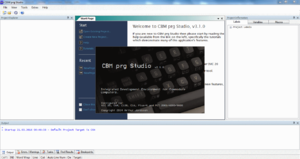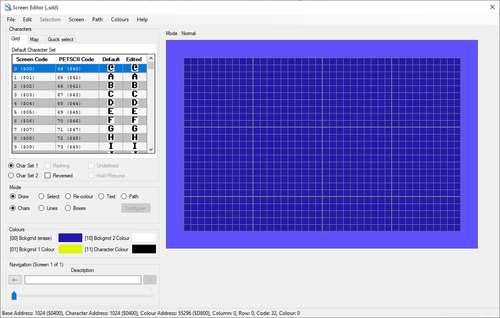CBM prg Studio
| CBM prg Studio | ||
|---|---|---|
 | ||
| Developer | Arthur Jordison | |
| Company | ||
| Publisher | ||
| Release | 2011 | |
| Licence | Freeware | |
| Platform | Windows | |
| Genre | Cross-Development IDE | |
| Operation | ||
| Media | - | |
| Language(s) | ||
| Information | version 4.7.0 (14.09.2025) http://www.ajordison.co.uk/ | |
CBM prg Studio is a freeware Windows IDE (Integrated Development Environment) used for the development of Commodore 8-bit programs, written by Arthur Jordison using C# and Visual Basic .NET.
Overview[edit | edit source]
The IDE can be used to create software for the following machines:
- C64 / 128
- C16 / Plus/4
- VIC20 (unexpanded, 3K expansion and >8K expansion)
- PET 2001 (BASIC 2)
- PET 4000/9000 (BASIC 4)
- Mega65 (BASIC65)
The main tools in CBM prg Studio are:
- Assembler and Disassembler for MOS 6502/6510/65816 CPUs (native and Kick Assembler)
- Character Editor (CBM prg Studio)
- Debugger
- Memory Manager (CBM prg Studio)
- Sprite Editor (CBM prg Studio)
- SID tool (with MIDI support)
- Screen Designer (CBM prg Studio)
- Program import: .prg, .T64 or .D64/.D71/.D81
- Program export: .prg, .p00
- Binary file import and export
- Git integration
CBM prg Studio is an on-going project which is updated every now and again. Version 4.7.0 was released on 14th September 2025.

History[edit | edit source]
CBM prg Studio started out back in 2006 as C64PrgGen, which was a very simple application which could create a prg file from a BASIC source file. Over time, tools such as an assembler and sprite and character editors were added and also VIC20PrgGen was written to create programs for the VIC20. Both programs were developed individually and had different functionality (the VIC20 version does not need a sprite editor, for example). A major disadvantage of this was most bug fixes had to be applied to both versions, effectively doubling the development time. Also, adding support for a new machine type would mean having a third version to support, and so on. Around 2010 it was decided to 'merge' both versions into a single IDE and in January 2011 the first beta version was released. CBM prg Studio is vastly different from the 'prgGen' applications as it is:
- MDI, meaning more than one source file could be edited at a time.
- Project based, so a prg could be created from more than one source file.
After much feedback and bugfixing version 1.0.0 was released in May 2011.
Other Features[edit | edit source]
As well as the above tools, CBM prg Studio also comes with a comprehensive help system which contains an FAQ, memory maps, BASIC 2.0 reference and examples and tutorials which cover the main features. There are also a number of BASIC and assembly sample programs, categorised by machine type.